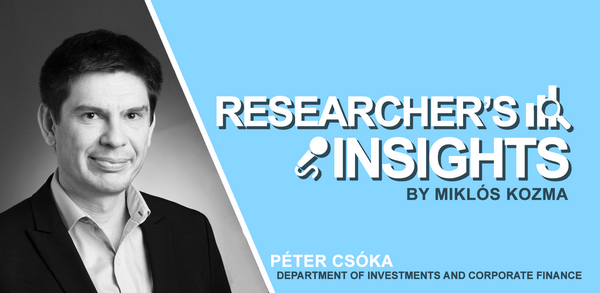Decentralized Solutions to Cooperation Dilemmas – the benefits of a financial network model in everyday life

On a peaceful weekend morning, I sat down to talk to Péter Csóka, researcher of the Department of Investments and Corporate finance about his frequently mentioned article published in Management Science, one of the top ten scholarly journals on strategy and management. What is behind the success, what are the takeaways?
Finance for financial experts or something else?
The title of the article “Decentralized clearing in financial networks” is not very comely to the layman. Economists with less affinity towards Finance might turn the page, but are ill advised in doing so. The article by Péter Csóka and his former Dutch PhD supervisor Jean-Jacques Herings draws conclusions that might be used in numerous wakes of life. The model that had originally been devised by the authors to analyse financial networks helped prove that in a large number of cases circular indebtedness could be addressed through decentralized clearing procedures as efficiently as if centralized clearing procedures were used. As a result, it is not necessary to collect sensitive data from numerous agents and operate a slow, expensive and costly mechanism.
In what areas of life could the findings be applied?
The findings of the article could be used by universities in exchanging students with other universities, in offices in managing IT server capacities, in the context of supply chains between companies, in coordinating the time management of multi-partner projects, in art treasure investments, in defining the number of MPs of political constituencies in an equitable manner or to return to the university: in allocating thesis evaluations to colleagues. Péter Csóka and Jean-Jacques Herings actually claim that if certain conditions apply, the community can find just as good solutions at system level as if the information was collected centrally and agents were prompted as to what they should do to achieve the best solution.
How to convey these valuable results to the largest possible number of potentially interested parties?
Péter Csóka is also very active in the area of the dissemination of scientific findings. He had made sure to publish the first version of the article as a working paper to promote it well before it was printed in an international journal roughly two years after its completion. They had it featured in various lists, they had it posted among others on RePEc, LinkedIn and Kudos and it also came to show up on at the top of relevant Google searches. The effort paid off as it prompted the CEO of a blockchain consortium to get in touch. Further reflection on the potential implications led to updating the article, thus rendering it even more compelling. They authors featured the topic at several conferences and made sure that participants could read the working paper prior to the event in order to prepare them for exchanges.
Success was brought about by the constellation of a number of factors. First, Péter Csóka works a lot, often up to 58 hours a week, he is a member of a constructive Hungarian and international community. His former PhD supervisor is also very active, publishes extensively and is a true role model for Péter. Second, Péter simultaneously works on 8-10 scientific papers which are in different stages from creation to publication. He writes these articles with a co-author and is on excellent terms with each co-author, he likes to be with them, think with them and talk to them: as a matter of fact, it means more to him than work in the strict sense of the term. He co-operates with his MSc and PhD students as well. Moreover, his activities strengthen each other through synergies: all his publications, university lectures, thesis consultation seminars are linked to his favourite research topics. With heart and soul, efficiently, that is where the secret lies, at least at first sight…
Miklós Kozma
Department of Business Studies
